The Microsoft Surface Laptop 3 Showdown: AMD's Ryzen Picasso vs. Intel's Ice Lake
by Brett Howse & Andrei Frumusanu on December 13, 2019 8:30 AM ESTGPU Performance - Vega vs Iris
After many tests, it is very clear that Intel’s Ice Lake platform offers a significantly faster CPU, and the results were unsurprising. Although the Ryzen Mobile 3000 platform did launch in 2019, it already struggled on CPU tests against the older Skylake core processors. But on the GPU side, Intel is the one that needs to play catch-up. Previous to Ice Lake, Intel’s standard GT2 GPU platform, found on almost all U-Series 15-Watt processors, offered 24 execution units of their Gen 9.5 GPU. AMD squeezed their Vega GPU architecture into their Ryzen SoC, which could easily double the performance of the Gen 9.5 GT2 GPU.
Ice Lake is Intel’s first real attempt to make a powerful iGPU a standard feature for their CPUs, although it is only a first step. But the new Gen 11 architecture brings some improvements such as more advanced tile-based rendering, variable rate shading, and of course the LPDDR4X-3733 memory adding significant bandwidth, greatly helping the GPU. The biggest change though is just how much die space Intel has dedicated to graphics, jumping from 24 EUs on a full GT2 to 64 EUs on a full GT2 part such as the Core i7-1065G7. And, following in AMD’s footsteps again, Intel is offering cut-down GPUs on lower-spec processors. It’s confused their already confusing processor naming, but the lowest-spec Core announced so far still has 32 EUs, meaning it is still better than the previous gen even at the “G1” level.
AMD has some tricks up their sleeves as well. For the Surface Laptop 3, Microsoft requested a slightly more powerful configuration for their Surface-branded processor. While the CPU side matches the same specifications as the non-Surface CPUs, Microsoft's processor SKUs add an extra GPU Compute Unit to both its Ryzen 5 and Ryzen 7, bringing them to 9 and 11 respectively. So the Surface Laptop 3 should be the best possible showcase for GPU performance on the 3000 series Ryzen mobile APU.
Before the results, let’s go over the driver situation. The Intel system ships with an updated driver over what we used on the Dell XPS 13 2-in-1, which resolves the 3DMark issues we saw on that laptop. The driver is from 2019-11-06 and is version 26.20.100.7463. The AMD platform’s driver is from 2019-10-07 and is version 26.20.12027.5004. Unfortunately, the AMD driver can’t be updated from AMD directly, and instead will be released by Microsoft. The current driver has some quirks, so an updated driver is needed for usability, but it did not prevent any GPU workloads from being run. But, the AMD system would only output 1280x720 where we normally test at 1366x768, and attempts to output to an external monitor were thwarted by the buggy driver, so be aware that in most of the gaming tests, the AMD system was outputting at a slightly lower resolution.
Let’s see how the do starting with some synthetics, and then moving to some real-world games.
3DMark
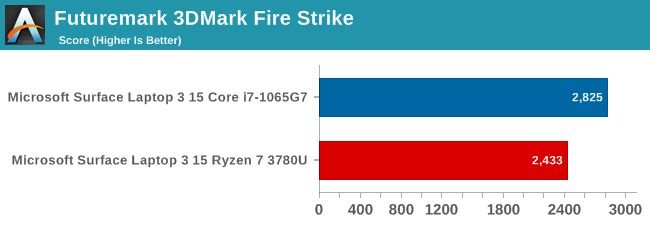
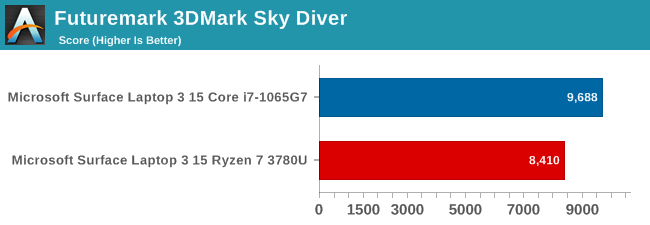
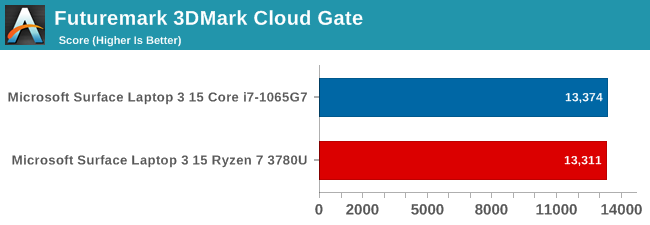
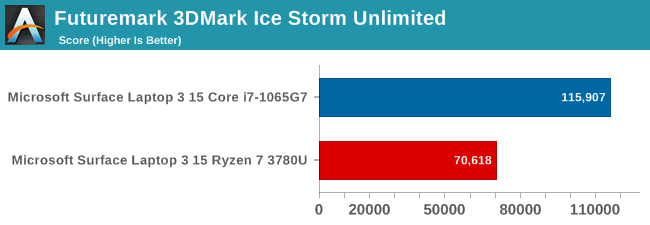
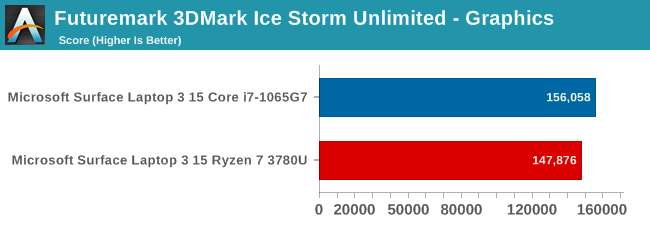
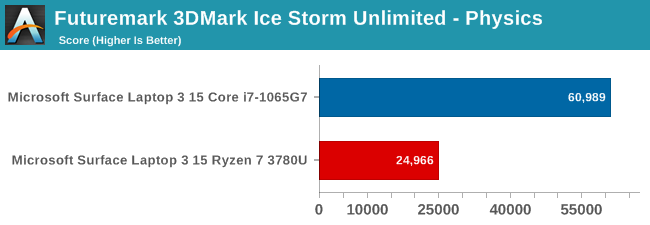
3DMark offers several tests of varying complexity, from Fire Strike as the most demanding, to Ice Storm Unlimited, which can be run on tablets. Here the Ice Lake platform pulls ahead, with better CPU performance helping quite a bit, although the Ice Lake’s Iris Plus graphics is also able to outperform Vega 11 as well.
GFXBench

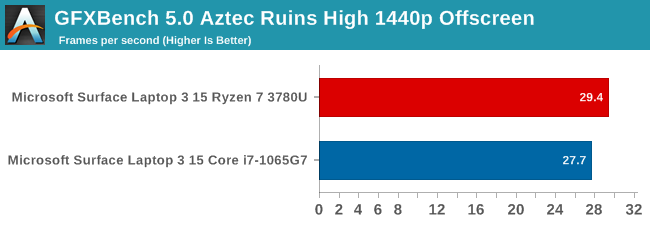
Kishonti’s latest GFXBench suite added DirectX 12 tests to the fold, making it far more relevant than the older OpenGL versions available on the desktop previously. AMD’s previous work in low-level drivers when they developed Mantle has provided the groundwork for DX12 as well, with Vega 11 offering slightly better results than Iris Plus in this test.
Tomb Raider

Running at our value settings, Tomb Raider was easily playable on both systems, with framerates approaching 100 FPS. The Ice Lake platform performed better on this test.
Rise of the Tomb Raider
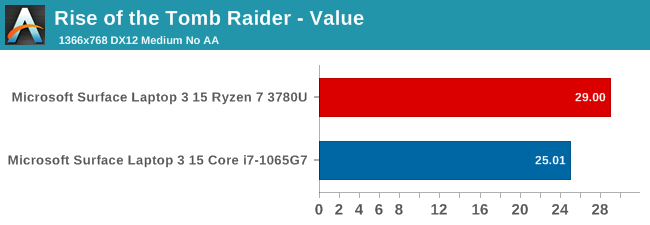
The second installment in the Tomb Raider series offers much more demanding visuals, and both systems struggle to play it at our value settings. The DirectX 12 title performs slightly better on Vega, and with some additional settings tweaks, the game would be playable, which is not something you could have said on an integrated GPU previous to Ryzen and Ice Lake.
Strange Brigade
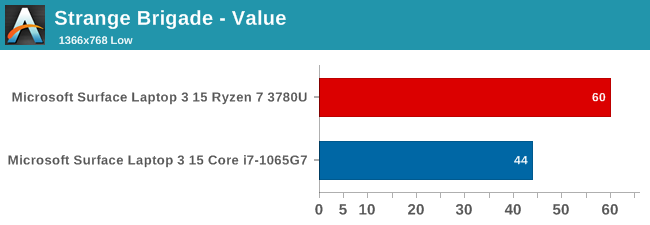
A new title we’re bringing to our laptop suite is Strange Brigade, which scales down nicely on integrated graphics. This game also supports DirectX 12, and as tends to be the pattern, performs very well on Vega 11.
F1 2017
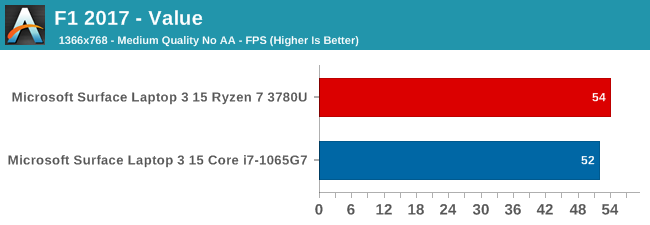
Back with a DirectX 11 title, we see that Intel has again closed the gap, and this game tends to be somewhat CPU bottlenecked as well, so the Sunny Cove cores likely help out here too, but once again Vega 11 wins, if only by a nose.
F1 2019
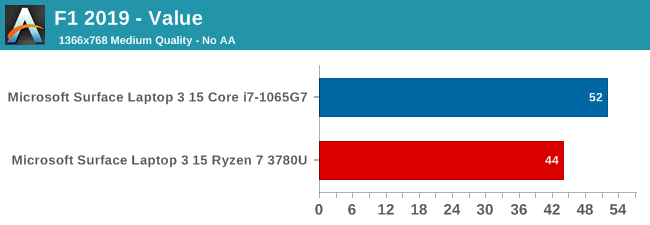
Codemasters updated the underlying EGO engine to support DirectX 12, which was utilized on this test. Despite that, the Vega 11 GPU is a bit slower than the Iris Plus in this test.
Far Cry 5
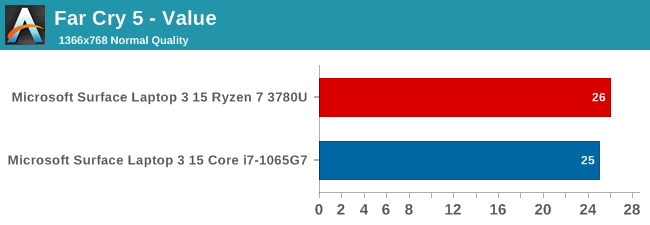
Both systems are within striking distance of being playable, which is somewhat remarkable since the Far Cry series is one of the most popular AAA first-person shooters. The Vega 11 GPU was slightly ahead, which is somewhat surprising as this game tends to be CPU bound, but clearly at this low of a GPU limit that hasn’t come into play yet.










174 Comments
View All Comments
lmcd - Friday, December 13, 2019 - link
There was a window where Intel was still mostly shipping dual-core i5s while AMD shipped the 2500U and 2700U for around the same price. Made for an interesting situation where the AMD units were effectively light-weight desktop replacements, while the Intel units served as ultralights, all while theoretically serving the same market.Point being, there already was a moment where AMD laptop recommendations have made sense.
Also worth noting that Intel's H-series laptops would be a great place for AMD to compete. I'm still unconvinced AMD's core design scales down that well, and afaik Ryzen Mobile still uses the desktop process nodes? So this might be an area where Intel still has a manufacturing advantage -- midrange power consumption.
Teckk - Friday, December 13, 2019 - link
Yes. Need more wins with HP and Dell, something like XPS. Not happening till mobile Zen2 at the very least.nathanddrews - Friday, December 13, 2019 - link
Ice Lake + G7 is giving me flashbacks to the Pentium M/Yonah era buzz.strahinja78 - Friday, December 13, 2019 - link
yeah,...and that wouldn't be good for AMDGreenReaper - Friday, December 13, 2019 - link
They need Zen 2 out on mobile. It'd sort at least half of the performance issues. Better memory would help there, on power, and with graphics as well.MBarton - Monday, December 30, 2019 - link
Zen 2 mobile is a low priority when server and HPDT have much higher margins. AMD needs to offer something competitive when they can afford to, but their margins is key to their financial recovery. Semi-custom CPU's for consoles are low margin, but at least in that case the volumes are so high and they're gaining a potential advantage in gaming by pushing game developers to optimize for RDNA.nathanddrews - Friday, December 13, 2019 - link
But it would be good for the consumer to get some serious computing power with energy efficiency in the mobile space that has otherwise been stagnant for a while.HStewart - Saturday, December 14, 2019 - link
The current Lice likes are consider lower watt models and replacements for higher end IceLake are probably in early 2020 - likely 6 and 8 core models and higher end GPU's.Not intended as gaming CPU's
Korguz - Sunday, December 15, 2019 - link
" higher end IceLake are probably in early 2020 - likely 6 and 8 core models and higher end GPU's. " um yea ok Hstewart, and you have proof of this how ?? my guess. you dont and this is just more of your pro intel opinions.HStewart - Friday, December 20, 2019 - link
Well it just base on Intel road maps with 10nm - it might not be Ice Lake and could be next version. There is no difference in this than people saying wait for Zen 3. So do you expect that Intel will be always on 14nm and current processor will only be on 10nm. Intel has expected roadmaps on 7nm and even far less, I believe and it just a feeling that this battle with chip size will be over next year. Just remember what Intel did during the Pentum 4 days with Frequency wars especial with Intel came out with I series. Until the Zen came out Intel was really look like a monopoly but in reality it is not just AMD was doing so poorly But AMD did Intel a blessing, competition helps company from being lazy and ineffectiveBut I just and older profession who send technology from the early days including original IBM PC with Intel 8088 cpu.